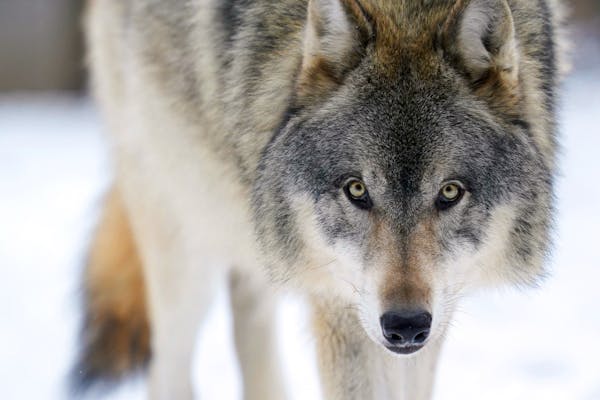A few miles outside of Voyageurs National Park, a researcher found a female wolf curled up under a tree. The wolf had been shot and killed by a poacher in the spring of 2022.
She was the breeding female of the Tamarack Pack, followed by the researchers of the Voyageurs Wolf Project. Her mate, the pack's breeding male, quickly abandoned the site after her death. He wandered, almost aimlessly, like any other lone wolf, and the pack dissolved, said Thomas Gable, lead of the Wolf Project.
Similar situations have played out for decades at national parks in Minnesota, Wyoming and Alaska. Human-caused deaths — mainly from poachers, legal hunters and vehicle collisions — have destabilized wolf packs, changing the social behavior of their surviving pack mates, according to a study published this week by researchers from Voyageurs, Yellowstone, Denali, Yukon-Charley Rivers and Grand Teton national parks.
Packs were more likely to dissolve if members were killed by a car or bullet than those that suffered more natural deaths, said Kira Cassidy, lead author and research associate with the Yellowstone Wolf Project.
The difference is especially drastic when a pack leader — either the breeding male or female — is killed by a human. Those packs were 73% more likely to fall apart by the end of the year.
"Packs are pretty important," Cassidy said. "And we know how important leaders are to things like territory and hunting behavior and reproducing and raising pups."
Voyageurs National Park is one of the only places in the Lower 48 that never lost all of its wolves. A few hundred survived in northern Minnesota as they were poisoned, trapped and shot out of the rest of the contiguous United States in the 20th century. A Star Tribune special report last year found that Minnesota's wolf population has been remarkably stable for the past 30 years, and ranchers and residents in the state have developed ways to keep conflicts between the predators and livestock and pets to a minimum.
Poaching and other human-caused mortality don't seem to change overall wolf populations much. In most cases, researchers say populations can remain stable even if up to 30% of wolves are killed each year.
The places occupied by the packs that dissolve don't stay vacant long. In the case of the Tamarack Pack near Voyageurs, trail-cameras picked up new wolves — including one with a distinctive stunted tail — that were already encroaching on the spot a few months before the breeding female was killed.
But the new study shows that humans are changing the dynamics of wolves in ways that scientists are only beginning to understand.
The animals are social and rely on each other to hunt prey and raise pups. In the spring, adult males produce a spike of a hormone called prolactin, which essentially gives them a craving for puppy-love and makes them act paternal to any young wolf they see. They'll bring back meat and food from their kills for the young.
"When they can't find meat, I've seen big males bring back toys — even things like traffic cones — for them to play with," Cassidy said.
That dynamic is wiped away when a pregnant wolf or a breeding female is killed.
Older wolves are also crucial in some cases to a pack's survival, Cassidy said.
One of the most common natural causes of a wolf fatality is an attack by other wolves, usually from a competing pack fighting over territory.
"The leadership in elderly wolves is really valuable in those fights," Cassidy said.
The national park system aims to keep animals acting as naturally as possible. While hunting is not allowed and poaching is exceedingly rare inside the parks, wolves have few protections when they roam outside the boundaries. The park service may need to make changes to things like speed limits inside parks, and work with states to create buffer zones that limit hunting or increase anti-poaching efforts near the parks.
Few studies have been done on what happens to the surviving members once the pack dissolves. It's possible some may disperse, traveling up to hundreds of miles in search of new territory and a mate. Some may try to hang on together nearby. Others may run into other wolf packs and be killed.
More research is also needed into what happens to packs that lose leaders to natural causes, Gable said.
In January 2022, the breeding male of the Lightfoot Pack in Voyageurs was killed by other wolves. It was one of the first wolves that Gable and the Voyageurs Wolf Project collared. As of this year, that territory was still occupied by his offspring — two females. This spring will tell if one of them is able to find a mate and keep the pack together — or if they will be ousted by competitors.
"His legacy lives on," Gable said.
Twins bring momentum into next series despite Angels Stadium struggles

Five home runs, including two by Julien, power Twins past White Sox

